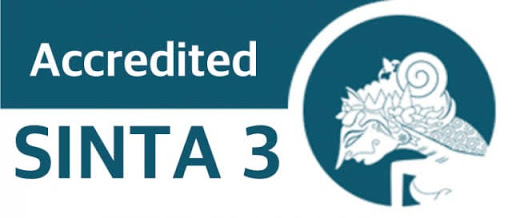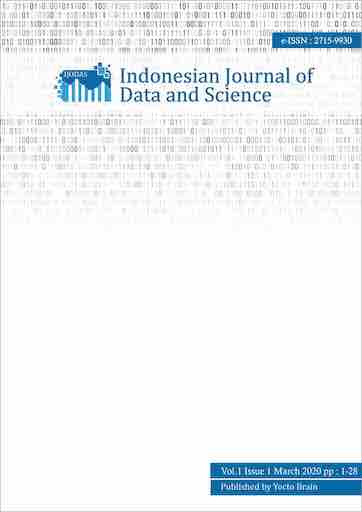Comparison Analysis of Random Forest Classifier, Support Vector Machine, and Artificial Neural Network Performance in Multiclass Brain Tumor Classification
Abstract
This study aims to analyze and compare the performance of three main classification models, namely Random Forest Classifier, Support Vector Machine, and Artificial Neural Network, in classifying Multiclass brain tumors based on MRI images. The research method includes exploratory data analysis (EDA), dataset preprocessing with image segmentation using the Canny method, and feature extraction using the Humoment method. The performance of the classification models is evaluated based on accuracy, precision, recall, and F1 score. The analysis results show variations in the performance of the three classification models, with Random Forest Classifier having an accuracy of 0.7, weighted precision of 0.55, weighted recall of 0.7, and weighted F1 score of 0.59; Support Vector Machine having an accuracy of 0.71, weighted precision of 0.5, weighted recall of 0.71, and weighted F1 score of 0.59; and Artificial Neural Network having an accuracy of 0.62, weighted precision of 0.6, weighted recall of 0.62, and weighted F1 score of 0.61. Visualization using box plots also reveals outliers in the performance of the three models. These findings indicate variations and outliers in the performance of the classification models for Multiclass brain tumor classification. Further analysis is needed to understand the factors that influence performance differences and identify ways to improve the classification model performance for brain tumor diagnosis based on MRI images
Downloads
References
M. Kristian, S. Andryana, and A. Gunaryati, “Diagnosa Penyakit Tumor Otak Menggunakan Metode Waterfall Dan Algoritma Depth First Search,” JIPI (Jurnal Ilm. Penelit. dan Pembelajaran Inform., vol. 6, no. 1, pp. 11–24, 2021, doi: 10.29100/jipi.v6i1.1840.
Ainani Shabrina Febrianti, Tri Arief Sardjono, and Atar Fuady Babgei, “Klasifikasi Tumor Otak pada Citra Magnetic Resonance Image dengan Menggunakan Metode Support Vector Machine,” J. Tek. ITS, vol. Vol. 9, No, no. 1, 2020.
R. Susetyoko, W. Yuwono, E. Purwantini, and ..., “Characteristics of Accuracy Function on Multiclass Classification Based on Best, Average, and Worst (BAW) Subset of Random Forest Model,” 2022 Int. …, 2022, [Online]. Available: https://ieeexplore.ieee.org/abstract/document/9888374/
A. S. Nugroho, R. Umar, and A. Fadlil, “Klasifikasi Botol Plastik Menggunakan Multiclass Support Vector Machine,” J. Khatulistiwa Inform., 2021, [Online]. Available: https://ejournal.bsi.ac.id/ejurnal/index.php/khatulistiwa/article/view/11058
R. Jayapermana, Implementasi Stacking Ensemble Classifier Untuk Klasifikasi Multi Kelas Topik Vaksin Covid-19 Pada Twitter. repositori.unsil.ac.id, 2021. [Online]. Available: http://repositori.unsil.ac.id/id/eprint/4671
R. Andre, B. Wahyu, and R. Purbaningtyas, “Klasifikasi Tumor Otak Menggunakan Convolutional Neural Network Dengan Arsitektur Efficientnet-B3,” J. IT, vol. 11, no. 3, pp. 55–59, 2021, [Online]. Available: https://jurnal.umj.ac.id/index.php/just-it/index
T. A. Mutiara and Q. N. Azizah, “Klasifikasi Tumor Otak Menggunakan Ekstraksi Fitur HOG dan Support Vector Machine,” J. Infortech, vol. 4, no. 1, pp. 45–50, 2022, [Online]. Available: https://ejournal.bsi.ac.id/ejurnal/index.php/infortech/article/view/12813
A. N. Nafisa et al., “Implementasi Algoritma Convolutional Neural Network Arsitektur Model MobileNetV2 dalam Klasifikasi Penyakit Tumor Otak Glioma , Pituitary dan Meningioma,” vol. 5, no. 1, pp. 53–61, 2023.
S. Amalia, I. Deborah, and I. N. Yulita, “Comparative analysis of classification algorithm: Random Forest, SPAARC, and MLP for airlines customer satisfaction,” SINERGI, 2022, [Online]. Available: https://www.neliti.com/publications/491968/comparative-analysis-of-classification-algorithm-random-forest-spaarc-and-mlp-fo
M. Azhari, Z. Situmorang, and ..., “Perbandingan Akurasi, Recall, dan Presisi Klasifikasi pada Algoritma C4. 5, Random Forest, SVM dan Naive Bayes,” J. Media …, 2021, [Online]. Available: http://www.ejurnal.stmik-budidarma.ac.id/index.php/mib/article/view/2937
D. ARIYOGA, … Metode Seleksi Fitur Filter, Wrapper, Dan Embedded Pada Klasifikasi Data Nirs Mangga Menggunakan Random Forest Dan Support Vector Machine (Svm). dspace.uii.ac.id, 2022. [Online]. Available: https://dspace.uii.ac.id/handle/123456789/38955
P. Wahyuningtias, H. W. Utami, U. A. Raihan, and ..., “Comparison Of Random Forest And Support Vector Machine Methods On Twitter Sentiment Analysis (Case Study: Internet …,” J. Tek. …, 2022, [Online]. Available: http://www.jutif.if.unsoed.ac.id/index.php/jurnal/article/view/168
I. Wardhana, M. Ariawijaya, V. A. Isnaini, and ..., “Gradient Boosting Machine, Random Forest dan Light GBM untuk Klasifikasi Kacang Kering,” … (Rekayasa Sist. dan …, 2022, [Online]. Available: http://jurnal.iaii.or.id/index.php/RESTI/article/view/3682
N. Husin, “Komparasi Algoritma Random Forest, Naïve Bayes, dan Bert Untuk Multi-Class Classification Pada Artikel Cable News Network (CNN),” J. Esensi Infokom J. Esensi Sist. Inf. …, 2023, [Online]. Available: https://ibn.e-journal.id/index.php/KOMPUTASI/article/view/608
R. I. Arumnisaa and A. W. Wijayanto, “Comparison of Ensemble Learning Method: Random Forest, Support Vector Machine, AdaBoost for Classification Human Development Index (HDI),” Sist. J. Sist. …, 2023, [Online]. Available: http://sistemasi.ftik.unisi.ac.id/index.php/stmsi/article/view/2501
E. Erlin, Y. Desnelita, N. Nasution, and ..., “Dampak SMOTE terhadap Kinerja Random Forest Classifier berdasarkan Data Tidak seimbang,” MATRIK J. …, 2022, [Online]. Available: https://journal.universitasbumigora.ac.id/index.php/matrik/article/view/1726
J. Ahmed and M. Ahmed, “Online news classification using machine learning techniques,” IIUM Eng. J., 2021, [Online]. Available: https://journals.iium.edu.my/ejournal/index.php/iiumej/article/view/1662
R. Rachmatika and A. Bisri, “Perbandingan Model Klasifikasi untuk Evaluasi Kinerja Akademik Mahasiswa,” JEPIN (Jurnal Edukasi dan Penelit. …, 2020, [Online]. Available: https://jurnal.untan.ac.id/index.php/jepin/article/view/43097
N. Arifin, “Klasifikasi Kematangan Buah Naga Berdasarkan Fitur Warna Menggunakan Algoritma Multi-Class Support Vector Machine,” J. Inform. Teknol. dan Sains, 2023, [Online]. Available: http://jurnal.uts.ac.id/index.php/JINTEKS/article/view/2203
S. Budiman, A. Sunyoto, and A. Nasiri, “Analisa Performa Penggunaan Feature Selection untuk Mendeteksi Intrusion Detection Systems dengan Algoritma Random Forest Classifier,” … J. Sist. Inf., 2021, [Online]. Available: http://sistemasi.ftik.unisi.ac.id/index.php/stmsi/article/view/1550
N. S. M. Tombel, H. F. M. Zaki, and ..., “FEATURE EXTRACTION AND SUPERVISED LEARNING FOR VOLATILE ORGANIC COMPOUNDS GAS RECOGNITION,” IIUM Eng. …, 2023, [Online]. Available: https://journals.iium.edu.my/ejournal/index.php/iiumej/article/view/2832
I. F. Rahman, Implementasi Metode SVM, MLP dan XGBoost pada Data Ekspresi Gen (Studi Kasus: Klasifikasi Data Ekspresi Gen Skeletal Muscle NGT, IGT dan Diabetes Melitus …. dspace.uii.ac.id, 2020. [Online]. Available: https://dspace.uii.ac.id/handle/123456789/23679
H. Azis, F. T. Admojo, and E. Susanti, “Analisis Perbandingan Performa Metode Klasifikasi pada Dataset Multiclass Citra Busur Panah,” J. Techno. Com, 2020, [Online]. Available: https://eprints.akprind.ac.id/1272/

Authors retain copyright and full publishing rights to their articles. Upon acceptance, authors grant Indonesian Journal of Data and Science a non-exclusive license to publish the work and to identify itself as the original publisher.
Self-archiving. Authors may deposit the submitted version, accepted manuscript, and version of record in institutional or subject repositories, with citation to the published article and a link to the version of record on the journal website.
Commercial permissions. Uses intended for commercial advantage or monetary compensation are not permitted under CC BY-NC 4.0. For permissions, contact the editorial office at [editorial email/contact form].
Legacy notice. Some earlier PDFs may display “Copyright © [Journal Name]” or only a CC BY-NC logo without the full license text. For the avoidance of doubt, authors hold copyright, and all articles are distributed under CC BY-NC 4.0. Where any discrepancy exists, this policy and the article landing-page license statement prevail.














